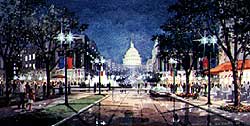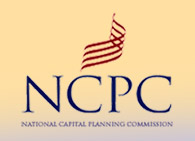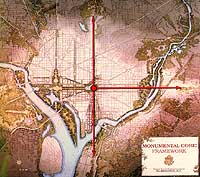 Extending the LegacyIn 1997, as part of its long-range planning responsibilities, the Commission released its framework plan for Washington, Extending the Legacy: Planning America's Capital for the 21st Century. The plan redefines Washington's monumental core and encourages new museums, memorials, and federal office buildings in all quadrants of the city.
Extending the Legacy preserves the historic character and open space of the National Mall and its adjacent ceremonial corridors while accommodating growth and new development. The plan expands the reach of public transit and eliminates obsolete freeways, bridges, and railroad tracks that fragment the city. It reclaims Washington's historic waterfront for public enjoyment, and adds parks, plazas, and other amenities to the urban fabric. Combing federal resources and local investment, Legacy will spur community renewal well into the 21st century. The National Capital Planning Commission, working with leading urban planning professionals and with business, community, and federal and local government partners, developed the plan in response to anticipated demands on the nation's capital. Tourism is expected to double during the next 50 years, automobile traffic could increase by a third in the next 20 years, and sites for many new memorials, museums, and federal buildings must be found.
Extending the Legacy continues Washington's tradition of visionary civic planning that began 200 years ago with the L'Enfant Plan that established the city's broad avenues and grand public spaces. The McMillan Plan of 1901 expanded on the L'Enfant vision by defining the National Mall as we know it today and designating sites for future parks, public buildings, and memorials. Extending the Legacy builds on these historic plans as it proposes new initiatives to meet the needs of the coming century. Like the L'Enfant and McMillan Plans before it, Extending the Legacy will be implemented by future generations. It took a century for L'Enfant's original vision to triumph over commercial expediency. Another 30 years passed before the Mall described in the McMillan Plan started to develop. Extending the Legacy will be no different. While some projects may be completed within a few years, others could take 20, 40, even 80 years depending on political and economic conditions. The plan is a vision; it is meant to guide—not prescribe—future development. Several of the plan's initiatives are becoming reality. These include the Circulator buses now rolling on Washington's streets, the revitalization of the South Capitol corridor, reclamation of the waterfront, the 2001 Memorials and Museums Master Plan and the National Capital Framework Plan, a joint project of NCPC and the U.S. Commission of Fine Arts, begun in 2006, which will focus on improving the areas around the National Mall and identifying new locations for national cultural attractions to relieve pressure on the National Mall and benefit the whole city. |
401 9th Street, NW
North Lobby, Suite 500
Washington D.C. 20004
Phone: (202) 482-7200
Fax: (202) 482-7272
Email: info@ncpc.gov
North Lobby, Suite 500
Washington D.C. 20004
Phone: (202) 482-7200
Fax: (202) 482-7272
Email: info@ncpc.gov


